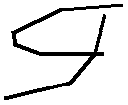
In an online publication titled "One Man’s Forgery Is Another Man’s Antiquity", he described it as having a leg that "does not have the sharpness expected of a genuine letter. Furthermore, the head of the bet is too rounded and somewhat disproportionate."
His description refers primarily to the "West Semitic Corpus" seal #30, well known for its rosette-adorned lyre & inscription, "LMODNE BT EMLK" ("[seal] of Madonna, daughter [of] the king"; sorry--can't resist that spelling of her name's transliteration since it makes it easier to remember), but which lacks provenance. According to him, the seal "could almost pass as genuine" with other letters he describes as "simply convincing" & one that's "particularly well executed."
While the Zayit Stone is a completely different medium from a completely different time incised by a completely different person, Wolfe's argument is weakened now that a similar form has been recovered from a scientifically secure excavation ("D'oh!"), but that doesn't necessarily mean that the seal is genuine, or that there's no such person forging ancient inscriptions with this style of Bet.
In between sessions at this point in my ASOR blog series, Robert Deutsch told me he's been in complete disagreement with this interpretation of a "lame" Bet all along, & indeed, he's been vocally supportive of the genuineness of the famous ivory pomegranate, which also contains a similar form, & which Wolfe points to as evidence of a forgery.
Personally, I'm indifferent since I don't claim any expertise in discerning genuine seals, just genuine seal impressions on jar handles. Regarding the Zayit Bet, I simply drew what I saw without knowing about the "lame Bet" issue. In any event, it was neat seeing Robert draw some specimens of Bets on my notebook at this point in the conference!
And speaking of Rosettes, at 10:55 I went to the "Copyright Law for Archaeologists and Other Academics" session, presided over by Rosette-queen, Jane Cahill. The people who "preside" over these sessions, generally don't say much, other than simply introduce the speakers, check for time-limits, & moderate the brief Q/A sessions. Nonetheless, it was nice to see her again. (And I got her to fall for one of the oldest tricks in the book when I tapped her on the shoulder from behind, while standing off to the opposite side! The score: LMLK researchers 1, Rosette researchers 0!) She introduced the session, featuring speakers from law professions, with the humorous reminder that what we'd be hearing was for educational purposes, & would not constitute legal advice!
I really would've loved to have stayed for this entire session, but only had time for the first part of Beth Sufian's presentation of "What a Copyright Is, How a Copyright Arises, Who Owns a Copyright, and What Rights a Copyright Bestows". To demonstrate how easy it is to violate a copyright without violating one's conscience, here's an illegal copy of the abstract:
"The professional need for archaeologists and other academics to publish scholarly reports and studies is so well known that the admonition 'publish or perish' has become a cliche. As this admonition has grown in force on university campuses, the quantity of scholarly research has come to exceed the capacity of academic publishers. Recognizing the bottleneck, commercial publishers have assumed an everincreasing share of the market for scholarly publication. Commercial publishers often attempt to insure [sic] their opportunity for profit by requiring authors to transfer copyright in their work to the publishers. Because scholars do not always conceive of publication as a source of direct financial benefit to themselves or their institutions, most willingly agree to what they believe is an inconsequential transfer of rights. Since transfer of rights to intellectual property is rarely--if ever--inconsequential, this paper will address what a copyright is, how a copyright arises, who owns a copyright, and what rights a copyright bestows. Issues explored will include the constitutional and statutory basis for copyright, the difference between ideas and the expression of ideas, authorship and originality, fixation, duration of copyright, work made for hire, noncopyrightable material, and copyright registration."
She began with some definitions, & emphasized that you can't copyright an idea or a fact, but you can copyright tangible expressions of an idea, or of a fact.
I slipped out, & should've waited about 4 minutes longer before doing so, so that I could have missed more of Eric Cline's conclusion to his paper, "From Noah’s Ark to the Ark of the Covenant and Beyond: A Call-to-Arms Against 'Junk Science,' Amateur Enthusiasts, and Uninformed Documentary Filmmakers".
Though I understand his general point, & appreciate his passion, & respect his dedication to his belief, his argument is weakened by his overwhelmingly negative bias towards the veracity of the Bible, siding (as most scholars do) with the dead Near East cultures whose numerous written records predate the relatively few written records of the living culture of the Jews.
It's late, & I had a long final day at the SBL conference, & am not sure if I want to address any specific issues raised by Eric Cline, so I'll sleep on it & either continue it tomorrow, or resume with the other ASOR lectures. Thanks for your patience!
G.M. Grena

No comments:
Post a Comment